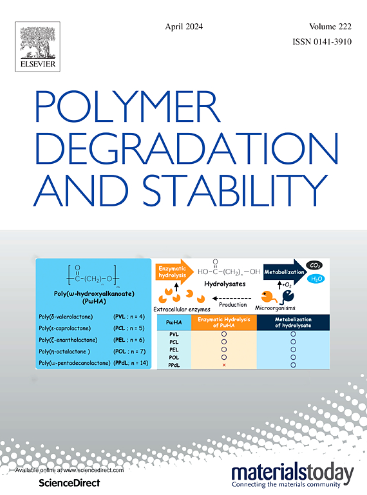Enhancing α- and β-glucan esters’ material selection through machine learning: An empirical study
IF 6.3
2区 化学
Q1 POLYMER SCIENCE
引用次数: 0
Abstract
Polysaccharide esters, with their potential as biomass plastics, represent sustainable alternatives to oil-based plastics. This study contributes to the optimization of material design by demonstrating that Materials Informatics (MI), combined with machine learning, can be effectively utilized to predict and enhance the properties of polysaccharide esters. The research methodology involved generating Simplified Molecular Input Line Entry System (SMILES) representations for polysaccharide esters, creating a novel dataset from scratch. By employing fourteen distinct machine learning models, the research successfully constructed a Quantitative Structure-Property Relationship (QSPR) model that accurately predicts and Elongation at Break of the given esters. Additionally, the study applied multiobjective optimization to these models, optimizing for both and Elongation at Break. This approach enables the efficient achievement of new material properties by significantly reducing the number of required experiments. The practical application of these models was further validated through laboratory experiments involving the synthesis and testing of proposed polysaccharide ester structures.
机器学习增强α-和β-葡聚糖酯材料选择的实证研究
多糖酯具有作为生物质塑料的潜力,是油基塑料的可持续替代品。本研究通过证明材料信息学(Materials Informatics, MI)与机器学习相结合,可以有效地用于预测和增强多糖酯的性质,从而有助于材料设计的优化。研究方法包括生成多糖酯的简化分子输入线输入系统(SMILES)表示,从零开始创建一个新的数据集。通过采用14种不同的机器学习模型,该研究成功构建了定量结构-性质关系(QSPR)模型,该模型可以准确预测给定酯的Tg和断裂伸长率。此外,研究还对这些模型进行了多目标优化,对Tg和断裂伸长率进行了优化。这种方法通过显著减少所需的实验次数,使新材料性能的有效实现。通过合成和测试多糖酯结构的实验室实验,进一步验证了这些模型的实际应用。
本文章由计算机程序翻译,如有差异,请以英文原文为准。
求助全文
约1分钟内获得全文
求助全文
来源期刊

Polymer Degradation and Stability
化学-高分子科学
CiteScore
10.10
自引率
10.20%
发文量
325
审稿时长
23 days
期刊介绍:
Polymer Degradation and Stability deals with the degradation reactions and their control which are a major preoccupation of practitioners of the many and diverse aspects of modern polymer technology.
Deteriorative reactions occur during processing, when polymers are subjected to heat, oxygen and mechanical stress, and during the useful life of the materials when oxygen and sunlight are the most important degradative agencies. In more specialised applications, degradation may be induced by high energy radiation, ozone, atmospheric pollutants, mechanical stress, biological action, hydrolysis and many other influences. The mechanisms of these reactions and stabilisation processes must be understood if the technology and application of polymers are to continue to advance. The reporting of investigations of this kind is therefore a major function of this journal.
However there are also new developments in polymer technology in which degradation processes find positive applications. For example, photodegradable plastics are now available, the recycling of polymeric products will become increasingly important, degradation and combustion studies are involved in the definition of the fire hazards which are associated with polymeric materials and the microelectronics industry is vitally dependent upon polymer degradation in the manufacture of its circuitry. Polymer properties may also be improved by processes like curing and grafting, the chemistry of which can be closely related to that which causes physical deterioration in other circumstances.
 求助内容:
求助内容: 应助结果提醒方式:
应助结果提醒方式:


